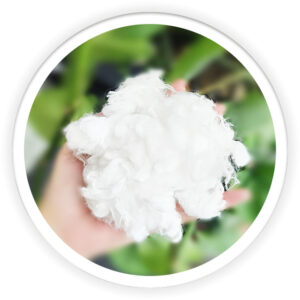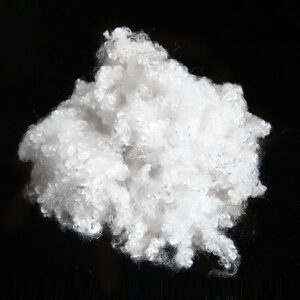U.S. International Trade Commission just released its third review publication no. 5456 to shed a light about US import of polyester staple fiber from China in the last 5 years. VNPOLYFIBER would like to summarize some main points of this review for interested audience.
Scope of polyester staple fiber from China
The merchandise subject to the order is synthetic staple fibers, not carded, combed or otherwise processed for spinning, of polyesters measuring 3.3 decitex (3 denier, inclusive) or more in diameter. This merchandise is cut to lengths varying from one inch (25 mm) to five inches (127 mm). The subject merchandise may be coated, usually with a silicon or other finish, or not coated. Polyester staple fiber is generally used as stuffing in sleeping bags, mattresses, ski jackets, comforters, cushions, pillows, and furniture.
The following products are excluded from the scope of the order: (1) Polyester staple fiber of less than 3.3 decitex (less than 3 denier) currently classifiable in the Harmonized Tariff Schedule of the United States (HTSUS) at 5503.20.0025 and known to the industry as polyester staple fiber for spinning and generally used in woven and knit applications to produce textile and apparel products; (2) polyester staple fiber of 10 to 18 denier that are cut to lengths of 6 to 8 inches and that are generally used in the manufacture of carpeting; and (3) low-melt polyester staple fiber defined as a bi-component fiber with an outer, non-polyester sheath that melts at a significantly lower temperature than its inner polyester core (classified at HTSUS 5503.20.0015).
U.S. tariff treatment
Subject certain PSF is currently imported under Harmonized Tariff Schedule of the United States (“HTS”) statistical reporting numbers 5503.20.0045 and 5503.20.0065, which are subject to a general rate of duty of 4.3 percent ad valorem. Decisions on the tariff classification and treatment of imported goods are within the authority of U.S. Customs and Border Protection.
Effective September 24, 2018, certain PSF originating in China was subject to an additional 10 percent ad valorem duty under section 301 of the Trade Act of 1974. Effective May 10, 2019, the section 301 duty for certain PSF was increased to 25 percent
Definition of polyester staple fiber by US ITC
Certain PSF is a manmade fiber that is similar in appearance to cotton or wool fiber when baled. Certain PSF is principally known in the industry as “fiber for fill,” as it is primarily used as polyester fiberfill. Certain PSF is generally used as stuffing in sleeping bags, mattresses, ski jackets, comforters, cushions, pillows, and furniture. Certain PSF has physical characteristics that distinguish it from other polyester staple fibers (such as carpet fiber and fiber for spinning), including the denier of the fiber, the length of the fiber, and in some cases the finish and “crimp” of the fiber. Most synthetic fiber is sold by quantity based on the denier of the fiber.
Because certain PSF is principally used as fiberfill, it is seldom visible in the end use product. Therefore, the appearance of certain PSF can be less important than its performance23 to customers. However, the appearance of certain PSF directly affects the look and perceived value of many end-products, such as mattresses, comforters, cushions, pillows, and furniture with less opaque upholstery.
Certain PSF used for fill can be produced in many variations for purposes of quality enhancement. For example, the subject fiber may be crimped or conjugated—i.e., in the first stage of conjugate PSF production, two polymers of differing viscosities are forced through a Y-shaped extruder before being blasted with cold air to make a single fiber. Conjugate PSF has a three-dimensional spiral twist in the fiber made from two types of fiber by either a chemical or mechanical process, designed to provide greater loft or fill capacity to the fiber for stuffing purposes. By contrast, non-conjugate fiber undergoes polymer formation before being extruded through a shower-head like spinneret and solidified with a blast of cold air.
Non-conjugate PSF has a two-dimensional saw tooth crimp and provides somewhat less fill capacity. Certain PSF may also be coated with a finish (usually silicone or oil-based), making the fiber smoother to the touch for certain high-end uses.24 The subject fiber may vary in shape and may be hollow or solid, depending on both the preference of the manufacturer and the end use of the fiber.25 Raw materials used to produce certain PSF may also vary. PSF can be made by reacting ethylene glycol with either terephthalic acid or its methyl ester; if so produced, it is termed virgin PSF. Virgin PSF is characterized by the purity of the whiteness of the fiber. PSF may also be made from recycled polyester, using either consumer waste, such as polyethylene terephthalate (“PET”) bottles, or industrial waste, such as polyester chips or spun tow. Fiber made in this way is known as regenerated or recycled fiber and does not contain virgin fiber. Some producers of the subject fiber also manufacture a blend of virgin and recycled/regenerated materials by introducing recycled/regenerated polyester chips into the virgin production line. Finally, certain PSF may be produced in the form of a low-melt fiber. This is a bi-component fiber with an outer sheath that melts at a significantly lower temperature than its inner polyester core, for purposes of thermal bonding, and is not included within the scope of this review.
Manufacturing process of polyester staple fiber
The manufacturing process for certain PSF may be divided into two discrete stages. The first stage of the process is polymer formation, which can vary depending on whether virgin (unprocessed chemicals) or recycled materials are being used. Polymer formation also varies depending on whether conjugate fiber or low-melt fiber is being produced. The second stage of the process, which is common to all certain PSF, is fiber formation, including stretching, cutting, and baling.
The manufacture of certain PSF from virgin materials begins by reacting ethylene glycol with either terephthalic acid or its methyl ester in the presence of an antimony catalyst. The reaction is carried out at a high temperature and in a vacuum to achieve the high molecular weights needed to form useful fiber. The mix is then sent through an esterification process before it is polymerized. Esterification is the chemical process of combining an acid with an alcohol to form an ester. If a blend of virgin and recycled materials is to be produced, the recycled material (usually in the form of polyester chips) is introduced at the esterification stage. After polymerization, the solid, molten plastic, which has a consistency similar to cold honey, must be heated and liquefied before it can be extruded. The liquid fiber-forming polymers are then extruded through tiny holes of a spinneret, a device similar to a showerhead, to form continuous filaments of semi-solid polymer. The denier of the fiber is controlled by the size of the holes on the spinneret. After extrusion, the semi-solid fibers are blasted with cold air to form solid fibers. This process is known as continuous polymerization.
In the first stage of production, unlike non-conjugate PSF, which requires a single spinning process, conjugate PSF is produced using a double spinning process either by direct spinning or batch spinning. Whether direct or batch spinning, conjugate fibers are composed of a bipolymer blend of two different polyester polymers of different viscosities. One of the polymers shrinks more than the other, resulting in spiral-shaped crimps. Conjugate and non-conjugate are typically made on separate manufacturing lines, and one line would not ordinarily be switched from one PSF type to the other. However, the same employees are used to produce conjugate PSF and other types of certain PSF. After the conjugate PSF is extruded, the stretching, cutting, and baling of the conjugate PSF is identical to other types of certain PSF.
The manufacture of regenerated certain PSF begins with the processing of the recycled materials. As reported in the original petition, regenerated certain PSF inputs can consist of a variety of different types of materials including virgin first quality chip, virgin off-spec chip, postindustrial (regenerated) pellet waste, post-industrial (regenerated) film waste, post- consumer bottles, post-consumer bottle flake, and miscellaneous post-industrial (regenerated) waste. Depending on the materials used, the recycled product is cleaned and either chipped or pelletized before being sent to the extruder. The recycled material is then melted to form molten polymers and sent through the spinneret to form continuous filaments of semisolid polymer. As with fiber from virgin materials, the polymer is then blasted with cold air to form solid fiber.
The second stage of production is common to fibers made from either virgin or recycled materials, including conjugate. The solid fiber is coated for the first time with an oil finish, usually only for internal use to facilitate further processing. The spun tow, as it is now known, is collected into a can to be stretched. The spun tow is sent over a creel and a series of “draw wheels” to orient the fiber molecules and strengthen the tow. Next, the tow is sent through a crimping machine, which gives the fiber tow a two-dimensional, saw-tooth shape. The tow is then sent through an oven to heat-set the crimp. A second finish (usually silicone or some type of oil-based finish) may be added during this stage of the process, either before the fiber tow is crimped and heat-set or directly after, depending on the preference of the manufacturer.
Finally, the fiber tow is cut to length and baled.
The manufacturing processes for nonsubject PSF are similar to those for certain PSF. Nonsubject PSF includes PSF of less than 3 denier, PSF for carpeting, and low-melt PSF, in addition to other products. These nonsubject forms of PSF may be manufactured on the same equipment and machinery used in the production of certain PSF. The production of PSF of less than 3 denier, commonly referred to as fine denier PSF, is controlled by the size of the holes on the spinneret. By using a spinneret with smaller holes, a production line can switch from heavier gauge PSF to finer denier; the other steps of the manufacturing process remain generally the same. PSF for carpeting is a higher denier than certain PSF and is produced by using a spinneret with larger holes. To achieve carpet fibers with luster, a slightly different mix of raw materials is used. Finally, low-melt fiber is produced using a very similar process to conjugate fiber. Like conjugate fiber, low-melt fiber can be produced by both a direct spinning system or a batch system. Component polymers are forced through a Y-shaped extruder to form a single fiber. A chemical ingredient is added to make the outer sheath polymer subject to a lower melting point. The fiber is then stretched, cut, and baled.
U.S. imports of polyester staple fiber
Table below presents the quantity, value, and unit value of U.S. imports of certain PSF from China as well as the other top sources of U.S. imports (shown in descending order of 2022 imports by quantity).
| U.S. imports from | Measure | 2017 | 2018 | 2019 | 2020 | 2021 | 2022 |
| China (subject) | Quantity | 245,536 | 276,091 | 211,978 | 179,597 | 144,792 | 119,374 |
| South Korea | Quantity | 131,275 | 140,372 | 146,747 | 118,640 | 107,585 | 131,372 |
| Vietnam | Quantity | 28,010 | 66,703 | 77,119 | 107,698 | 147,440 | 128,287 |
| Thailand | Quantity | 35,098 | 40,661 | 42,762 | 69,459 | 92,126 | 103,048 |
| All other sources | Quantity | 125,369 | 143,350 | 153,168 | 156,751 | 181,379 | 159,090 |
| Nonsubject sources | Quantity | 319,753 | 391,086 | 419,797 | 452,548 | 528,529 | 521,797 |
| All import sources | Quantity | 565,289 | 667,177 | 631,775 | 632,145 | 673,322 | 641,172 |
| China (subject) | Value | 101,538 | 140,988 | 98,800 | 75,442 | 63,544 | 57,893 |
| South Korea | Value | 69,582 | 86,215 | 86,803 | 57,832 | 56,504 | 73,074 |
| Vietnam | Value | 13,952 | 38,065 | 40,558 | 48,808 | 70,602 | 65,023 |
| Thailand | Value | 16,845 | 23,985 | 24,356 | 33,228 | 49,098 | 66,032 |
| All other sources | Value | 86,625 | 106,752 | 102,698 | 85,984 | 113,852 | 122,455 |
| Nonsubject sources | Value | 187,003 | 255,018 | 254,414 | 225,852 | 290,056 | 326,583 |
| All import sources | Value | 288,542 | 396,006 | 353,215 | 301,295 | 353,600 | 384,476 |
| China (subject) | Unit value | 0.41 | 0.51 | 0.47 | 0.42 | 0.44 | 0.48 |
| South Korea | Unit value | 0.53 | 0.61 | 0.59 | 0.49 | 0.53 | 0.56 |
| Vietnam | Unit value | 0.50 | 0.57 | 0.53 | 0.45 | 0.48 | 0.51 |
| Thailand | Unit value | 0.48 | 0.59 | 0.57 | 0.48 | 0.53 | 0.64 |
| All other sources | Unit value | 0.69 | 0.74 | 0.67 | 0.55 | 0.63 | 0.77 |
| Nonsubject sources | Unit value | 0.58 | 0.65 | 0.61 | 0.50 | 0.55 | 0.63 |
| All import sources | Unit value | 0.51 | 0.59 | 0.56 | 0.48 | 0.53 | 0.60 |
Certain PSF: U.S. imports, by source and period (Quantity in 1,000 pounds; value in 1,000 dollars; unit value in dollars per pound)
Apparent U.S. consumption and market shares
Table below presents data on U.S. producers’ U.S. shipments, U.S. imports, apparent U.S. consumption, and market shares.
| Source | Measure | 2006 | 2011 | 2016 | 2022 |
| U.S. producers | Quantity | 500,161 | *** | *** | *** |
| China (subject) | Quantity | *** | *** | *** | 119,374 |
| China (nonsubject) | Quantity | *** | *** | *** | NA |
| Nonsubject sources | Quantity | *** | *** | *** | 521,797 |
| All import sources | Quantity | 566,730 | 507,269 | *** | 641,172 |
| Apparent U.S. consumption | Quantity | 1,066,891 | *** | *** | *** |
| U.S. producers | Value | 369,142 | *** | *** | *** |
| China (subject) | Value | *** | *** | *** | 57,893 |
| China (nonsubject) | Value | *** | *** | *** | NA |
| Nonsubject sources | Value | *** | *** | *** | 326,583 |
| All import sources | Value | 333,096 | 398,750 | *** | 384,476 |
| Apparent U.S. consumption | Value | 702,238 | *** | *** | *** |
| U.S. producers | Share of quantity | 46.9 | *** | *** | *** |
| China (subject) | Share of quantity | *** | *** | *** | *** |
| China (nonsubject) | Share of quantity | *** | *** | *** | NA |
| Nonsubject sources | Share of quantity | *** | *** | *** | *** |
| All import sources | Share of quantity | 53.1 | *** | *** | *** |
| U.S. producers | Share of value | 52.6 | NA | *** | *** |
| China (subject) | Share of value | *** | NA | *** | *** |
| China (nonsubject) | Share of value | *** | NA | *** | NA |
| Nonsubject sources | Share of value | *** | NA | *** | *** |
| All import sources | Share of value | 47.4 | NA | *** | *** |
Certain PSF: Apparent U.S. consumption and market shares, by source and period (Quantity in 1,000 pounds; value in 1,000 dollars; shares in %)
China Export of Polyester Staple Fiber to the world
Table below presents export data for PSF, a category that includes certain PSF and out-of- scope products, from China (by export destination in descending order of quantity for 2022). The largest destination market in 2022 was Vietnam, accounting for 15.0 percent of all Chinese exports of PSF. The top five export destination markets, Vietnam, Pakistan, Indonesia, Bangladesh, and the United States, collectively accounted for 42.7 percent of all PSF exported from China in 2022.
| Destination market | 2017 | 2018 | 2019 | 2020 | 2021 | 2022 |
| Vietnam | 184,996 | 224,348 | 260,562 | 307,820 | 372,930 | 329,374 |
| Pakistan | 166,026 | 165,044 | 147,597 | 144,364 | 247,505 | 221,147 |
| Indonesia | 217,230 | 279,202 | 231,086 | 88,032 | 165,823 | 153,021 |
| Bangladesh | 53,378 | 68,402 | 73,409 | 63,250 | 126,261 | 118,683 |
| United States | 367,811 | 358,546 | 232,729 | 184,383 | 179,292 | 115,166 |
| Brazil | 83,787 | 76,840 | 76,034 | 107,974 | 89,106 | 114,228 |
| Russia | 94,457 | 84,911 | 82,807 | 70,624 | 70,485 | 100,743 |
| India | 123,716 | 103,025 | 167,940 | 93,663 | 69,584 | 85,636 |
| Turkey | 56,539 | 89,672 | 69,327 | 33,980 | 36,559 | 82,344 |
| Israel | 107,199 | 110,572 | 106,651 | 75,564 | 51,890 | 76,912 |
| All other markets | 756,258 | 702,782 | 708,999 | 584,622 | 638,944 | 798,241 |
| All markets | 2,211,397 | 2,263,343 | 2,157,141 | 1,754,276 | 2,048,379 | 2,195,495 |
PSF: Quantity of exports from China, by destination and period (Quantity in 1,000 pounds)
Third-country countries posed anti dumping duty on China polyester staple fiber
According to the domestic interested parties, antidumping duty orders are in effect on imports of PSF from China, including certain PSF within the scope of this review, from Indonesia, Mexico, Pakistan, and Turkey. In addition, Turkey imposed a global safeguard measure on imports of PSF in September 2021.
| Country imposing remedy | Type of remedy | Covered Products | Date of duty imposition/renewal |
| Indonesia | Antidumping | Polyester staple fiber | December 2022 |
| Mexico | Antidumping | Short-fiber polyester | July 2019 |
| Pakistan | Antidumping | Polyester staple fiber | October 2021 |
| Turkey | Antidumping | Polyester synthetic staple fibers | October 2018 |
| Turkey | Safeguard | Polyester fiber | September 2021 |
PSF: Third-country trade actions on imports of PSF from China
The global export data for polyester staple fiber
Table below presents global export data for PSF, a category that includes certain PSF and out-of-scope products (by source in descending order of quantity for 2022). The two largest exporters, China and South Korea, together accounted for almost half (47.9 percent) of global exports of PSF in 2022.
| Exporting country | 2017 | 2018 | 2019 | 2020 | 2021 | 2022 |
| China | 2,211,397 | 2,263,343 | 2,157,141 | 1,754,276 | 2,048,379 | 2,195,495 |
| South Korea | 1,687,994 | 1,763,679 | 1,613,530 | 1,556,771 | 1,612,780 | 1,376,366 |
| Thailand | 608,875 | 674,832 | 732,432 | 830,015 | 795,617 | 701,225 |
| India | 486,692 | 554,398 | 604,670 | 632,770 | 829,749 | 561,133 |
| Taiwan | 842,614 | 777,014 | 667,416 | 621,589 | 608,164 | 496,612 |
| Indonesia | 311,871 | 396,938 | 583,637 | 553,722 | 543,274 | 468,291 |
| Turkey | 84,315 | 82,109 | 99,110 | 231,448 | 358,279 | 347,320 |
| Malaysia | 260,238 | 227,751 | 287,746 | 251,548 | 300,575 | 295,376 |
| Germany | — | — | — | — | — | 166,075 |
| Ireland | 190,036 | 187,775 | 182,920 | 169,857 | 188,827 | 129,475 |
| All other exporters | 1,158,917 | 1,325,743 | 1,421,611 | 1,376,422 | 1,591,529 | 624,773 |
| All exporters | 7,962,193 | 8,373,504 | 8,430,175 | 8,062,216 | 8,984,838 | 7,454,345 |
PSF: Quantity of global exports, by country and period (Quantity in 1,000 pounds)
For more details on this review, please visit US ITC to download its full review.
If you are interested in finding more suppliers of polyester staple fiber in Asian countries, please consider us and do not hesitate to contact us immediately!
Welcome any business coooperation!!!







